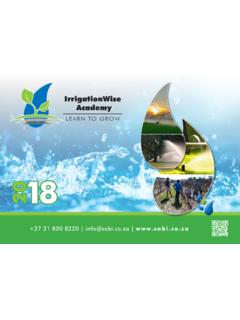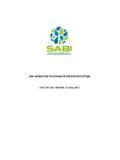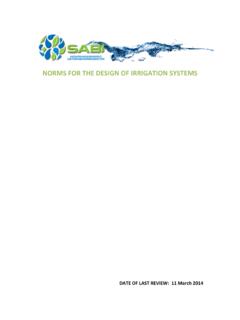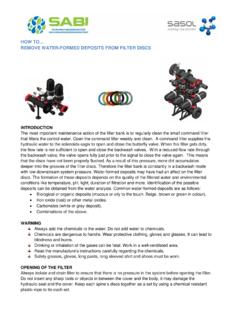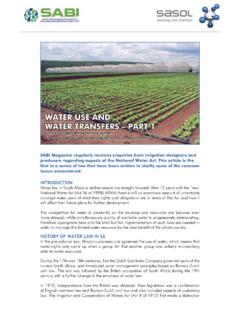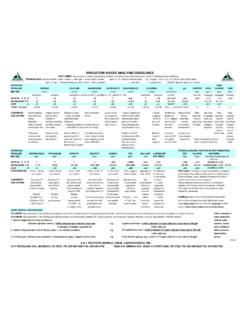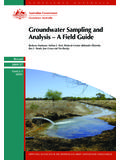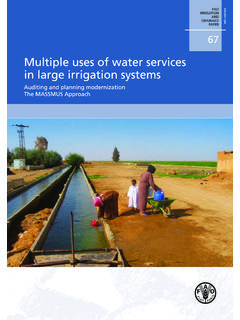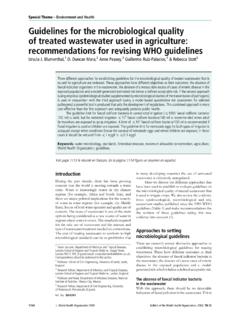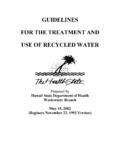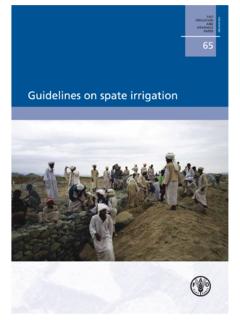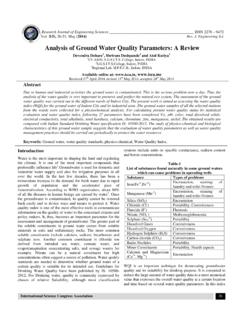Transcription of IMPACT OF WATER QUALITY ON IRRIGATION …
1 IMPACT OF WATER QUALITY ON IRRIGATION SYSTEMS. KORTLIKS. Bykans alle WATER bevat opgeloste soute en spoorelemente as gevolg van die natuurlike verweringsproses van die omgewing. Dreineringswater vanuit besproeiingsgrond, industri le afvalwater en huishoudelike uitvloeisel wat in strome en grondwaterbronne beland, be nvloed ook die waterkwaliteit daarvan. Probleme wat ontstaan, soos ho sout-inhoud van die WATER , het 'n effek op: die gewas-opbrengs(hoeveelheid en kwaliteit), die grond se volhoubare gebruik vir besproeiing, en die werkverrigting van die besproeiingstoerusting. Department van Waterwese het in 1996 Waterkwaliteitsriglyne gepubliseer, waarvan Volume 4. spesifiek op die gebruik van WATER vir besproeiing van toepassing is. Hierdie artikel kyk na die korrekte prosedures vir die neem van watermonsters vir ontleding deur 'n laboratorium, sowel as na die verskillende indekse wat gebruik kan word om die effek van die WATER se kwaliteit op die besproeiingstelsel te bepaal INTRODUCTION.
2 Nearly all WATER contain dissolved salts and trace elements, which results from natural weathering. Drainage WATER from IRRIGATION fields, industrial waste WATER and domestic misuse of WATER , also affect the QUALITY of WATER flowing in our rivers or found in groundwater aquifers. Problems such as high salinity levels of the available WATER , can negatively influence: the crop yield (quantity and QUALITY ), the soil's sustainability for IRRIGATION purposes, and the performance of the IRRIGATION system. The South African WATER QUALITY guidelines (2nd edition), Volume 4: IRRIGATION cover the WATER QUALITY guidelines published by the Department of WATER Affairs and Forestry in 1996. Similar guidelines for the other WATER use sectors. SAMPLE TAKING AND HANDLING REQUIREMENTS. The purpose of taking a sample is to use a container of sufficient volume that can be easily transported and handled so that the test laboratory can provide accurate analysis results.
3 For existing systems, the sample can be taken downstream of the filter to identify the IMPACT of fertigation on the IRRIGATION WATER . For design purposes and the compilation of a preventative maintenance schedule, the sample must be taken at the WATER source. The analysis must be done when the WATER QUALITY is at its worst and must be compared to historical figures to monitor any variations in WATER QUALITY . A complete record must be kept of samples handed in for analysis. It is preferable to use as SANAS or Agrilasa accredited approved laboratory. The following guidelines for sample taking are suggested (Beukes & Volschenk, 2001): Use an emply plastic or glass bottle, preferably plastic, to prevent breakage during transport. Rinse the bottle well three to four times with the WATER to be used for the sample.
4 If the sample is from a borehole, the pump must be switched on and must pump for at least an hour before the sample is taken. 1. WATER samples taken from a dam must be at a depth of at least 500 mm. When WATER from an IRRIGATION system is analysed, the laterals must be flushed sufficiently to ensure that a representative sample is taken. River WATER must be sampled in the flow of the river. Stagnant WATER can have a higher salt concentration. Mark the containers clearly. Provide the following information on the accompanying letter: Name, address and telephone number of farmer Sample number Type of crop to be irrigated WATER source ( dam, river or borehole). Type of IRRIGATION system used ( sprinkler, flood, micro, or moving systems). The following WATER sample preservation and storage practices are recommended if the immediate analysis of the sample is not possible: the best way to preserve most samples is to store it in the dark, at a low temperature (4 C).
5 The iron WATER sample must be filtered with a Whatmann 40 filter paper or an empty used tea bag. If the WATER is not filtered, it can cause higher iron readings. Table 1 illustrates the handling and storage requirements for IRRIGATION WATER samples. Table 1: Handling and storage requirements of WATER samples (Reinders et al, 2002). Ions Container Minimum Storage Maximu sample m size (m ) recomm ended storage period Electrical P,G 500 Refrigerate 28 days conductivity Metals P,G - For dissolved metals, filter 6 months immediately, add HNO to pH 2. Nitrates P,G -100 Analyse as soon as possible or 48 hours refrigerate or freeze at 20 . Nitrates & P,G 200 Add H SO to a pH 2 refrigerate None Nitrites pH P,G - Analyse immediately 2 hours Sulphates P,G 100 Refrigerate 28 days Suspended P,G 1000 Refrigerate 7 days solids Refrigerate = store at 4 C in the dark.
6 P = plastic (polyethylene equivalent); G = glass 2. THE EFFECT OF WATER QUALITY guidelines ON IRRIGATION . EQUIPMENT. The WATER must be tested for specific WATER QUALITY problems which may occur during the IRRIGATION season. Indexes provide an indication of scale forming and the corrosive potential of the WATER . Different indexes are used to identify if the IRRIGATION WATER is corrosive and/or if scale forming is a problem. No single index is infallible, so it is advisable to apply as many of the available indexes as possible. If it is recommeded that a more conservative approach is used for planning purposes, and it is also advisable to obtain an expert opinion regarding the indexes. Corrosive IRRIGATION WATER may lead to an early replacement of the nozzles. Indexes as WATER QUALITY guidelines A WATER analysis, with the appropriate WATER QUALITY guidelines , can be used to early identify if corrosion or scale forming will be a problem (Table 2 a d).
7 Table 2 a: guidelines of the Langelier index (DWAF, 1996). Langelier index Effect on IRRIGATION equipment < -2 Increasing problems with corrosion of metal and concrete - 2 - + No major problems with corrosion or scaling + Increasing problems with scaling of IRRIGATION pipes and emitters Table 2 b: guidelines of the Aggressiveness index (DWAF, 1996). Aggressiveness index Effect on IRRIGATION equipment > 12 Non-aggressive Moderately aggressive 10 Highly aggressive Table 2 c: guidelines of the Ryznar index (DWAF, 1996). Ryznar index Effect on IRRIGATION equipment < Scale forming tendency > Corrosive tendency Table 2 d: guidelines of the Corrosion ratio (DWAF, 1996). A ratio below indicates that corrosion is not a problem in slightly alkaline WATER . Higher ratios indicates a tendency towards progressive corrosion, aggressive waters (DWAF, 1996).
8 3. The effect of WATER QUALITY on the clogging of emitters: Physical: the clogging of emitters caused by the occurence of sand, silt and other suspended solids, either organic or inorganic in nature. Very fine particles will remain in suspension and may only presipitate at the end of laterals. A lot of particles can bind together where microslime deposits are available. Chemical: calcium and magenesium carbonate precipitants are formed at the outlet of the drippers if the pH of the WATER source is higher than Other chemical reactions are normally caused by iron and manganese oxides in boreholes. Biological: clogging is a result of algae growth and micro-biological activities. Clogging material is identified by the colour of the various presipitants for example, a carbonate presipitant appears white, iron oxide appears rust (red), manganese appears blue in colour, and micro-biological activities are black.
9 ACCURACY AND ACCEPTABILTIY OF WATER ANALYSIS. WATER QUALITY is usually measured by the total dissolved solids (TDS) or the electrical conductivity of the WATER (EC). A close relationship exists between the TDS of the WATER and the EC. Since EC is much easier to measure than TDS, it is used as an estimate of the total TDS concentration. The following relationship can be used: x EC (mS/m) = TDS (mg/ ). [DWAF, 1996]. To ensure that the Cations and the Anions balances, as measured in milli equivalent per litre (me/ ), since WATER is usually electrically neutral. If not, the test laboratory must be requested to repeat the analysis. Secondly, test for the relationship EC (mS/m) x =. TDS (mg/ ). Table 4 reveals the total anions and the total cations as well as the TDS. WATER QUALITY ANALYSIS REPORT.
10 The WATER must be tested for specific problems which may occur during the IRRIGATION season for example clogging of the drippers. Complete the applicable tables to ensure that the relevant data is available when needed. The contact details of a producer as well as the relevant information regarding the resources and the IRRIGATION system used is shown in Table 3 below. Table 3: Contact details of producer and the relevant information of the IRRIGATION system Submitted by: Crop data: Laboratory: Contact particulars: WATER source: Contact particulars: Sample number & date: Type of IRRIGATION system: Analysis date: 4. Table 4 illustrates the relevant information regarding the anions and cations of the IRRIGATION WATER source. Anions and cations were measured in mg/ , which are converted to me/.

